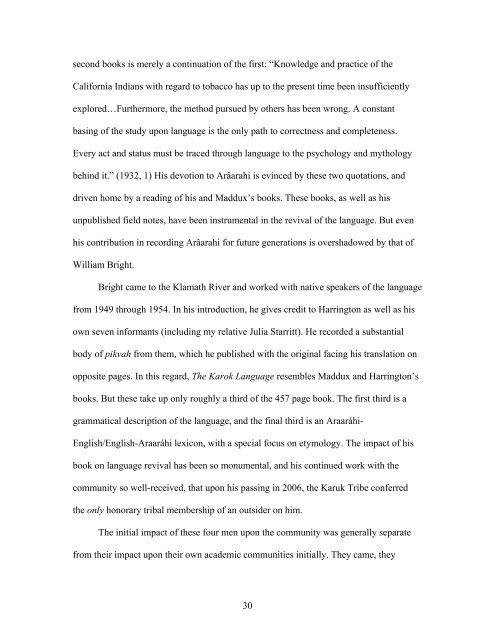The Intersection of Karuk Storytelling and Education
The Intersection of Karuk Storytelling and Education
The Intersection of Karuk Storytelling and Education
Create successful ePaper yourself
Turn your PDF publications into a flip-book with our unique Google optimized e-Paper software.
second books is merely a continuation <strong>of</strong> the first: “Knowledge <strong>and</strong> practice <strong>of</strong> the<br />
California Indians with regard to tobacco has up to the present time been insufficiently<br />
explored…Furthermore, the method pursued by others has been wrong. A constant<br />
basing <strong>of</strong> the study upon language is the only path to correctness <strong>and</strong> completeness.<br />
Every act <strong>and</strong> status must be traced through language to the psychology <strong>and</strong> mythology<br />
behind it.” (1932, 1) His devotion to Arâarahi is evinced by these two quotations, <strong>and</strong><br />
driven home by a reading <strong>of</strong> his <strong>and</strong> Maddux’s books. <strong>The</strong>se books, as well as his<br />
unpublished field notes, have been instrumental in the revival <strong>of</strong> the language. But even<br />
his contribution in recording Arâarahi for future generations is overshadowed by that <strong>of</strong><br />
William Bright.<br />
Bright came to the Klamath River <strong>and</strong> worked with native speakers <strong>of</strong> the language<br />
from 1949 through 1954. In his introduction, he gives credit to Harrington as well as his<br />
own seven informants (including my relative Julia Starritt). He recorded a substantial<br />
body <strong>of</strong> pikvah from them, which he published with the original facing his translation on<br />
opposite pages. In this regard, <strong>The</strong> Karok Language resembles Maddux <strong>and</strong> Harrington’s<br />
books. But these take up only roughly a third <strong>of</strong> the 457 page book. <strong>The</strong> first third is a<br />
grammatical description <strong>of</strong> the language, <strong>and</strong> the final third is an Araaráhi-<br />
English/English-Araaráhi lexicon, with a special focus on etymology. <strong>The</strong> impact <strong>of</strong> his<br />
book on language revival has been so monumental, <strong>and</strong> his continued work with the<br />
community so well-received, that upon his passing in 2006, the <strong>Karuk</strong> Tribe conferred<br />
the only honorary tribal membership <strong>of</strong> an outsider on him.<br />
<strong>The</strong> initial impact <strong>of</strong> these four men upon the community was generally separate<br />
from their impact upon their own academic communities initially. <strong>The</strong>y came, they<br />
30
















